International Financial Reporting: Company Performance Analysis Report
VerifiedAdded on 2023/04/22
|13
|3115
|193
Report
AI Summary
This report undertakes a comparative financial analysis of J Sainsbury Plc and The Go-Ahead Group Plc, focusing on their performance based on financial statements from 2017 and 2018. The analysis employs various financial ratios, including liquidity, activity, leverage, and profitability ratios, to assess the companies' financial health and efficiency. The report examines current and quick ratios for liquidity, total asset turnover and inventory turnover for activity, debt and debt-to-equity ratios for leverage, and net profit margin and return on equity for profitability. It highlights the strengths and weaknesses of each company, considering both financial and non-financial factors. The report concludes with an overall assessment of the companies' financial standings, offering insights into their operational and financial strategies, and their ability to meet short-term obligations and generate earnings. The report also considers limitations of ratio analysis and performance factors for each company.
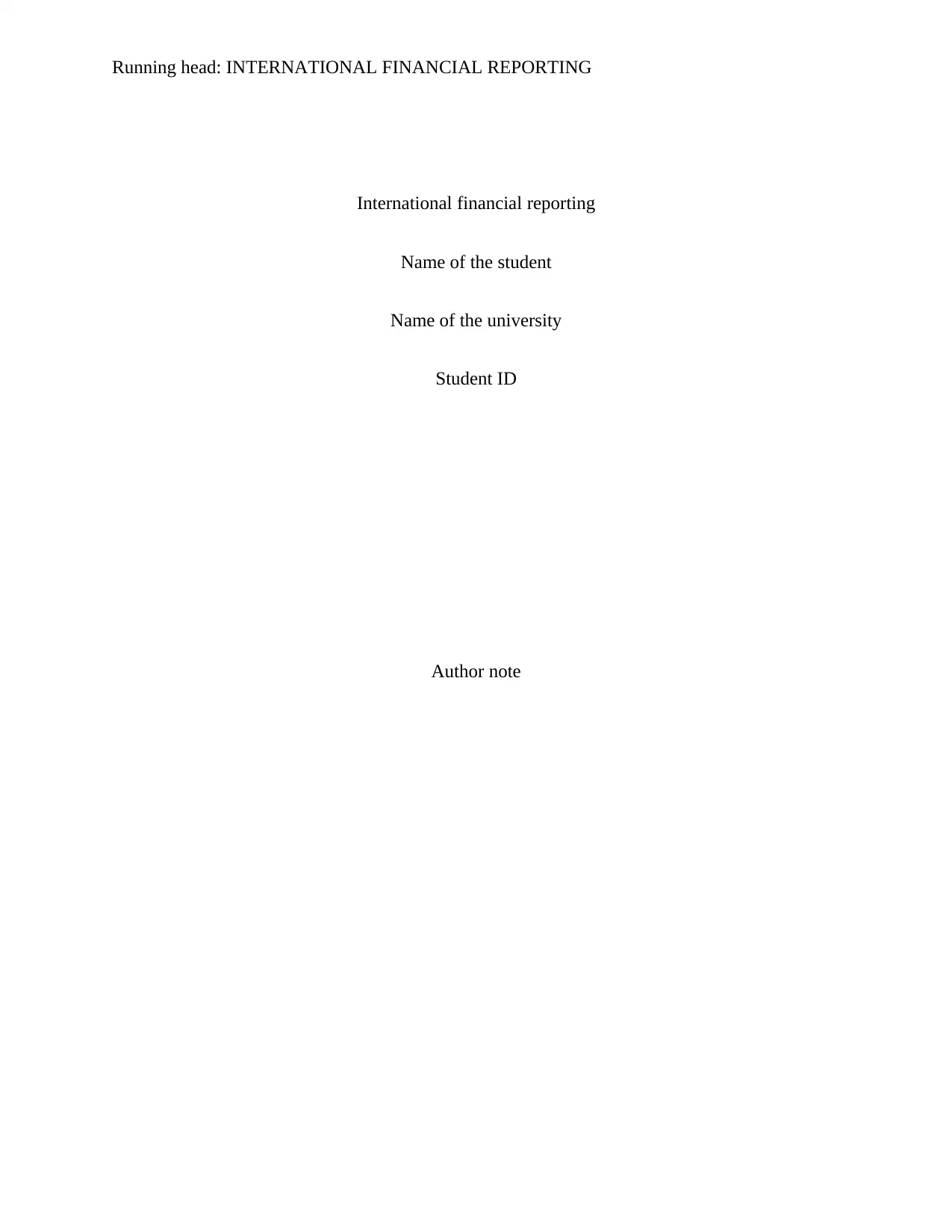
Running head: INTERNATIONAL FINANCIAL REPORTING
International financial reporting
Name of the student
Name of the university
Student ID
Author note
International financial reporting
Name of the student
Name of the university
Student ID
Author note
Paraphrase This Document
Need a fresh take? Get an instant paraphrase of this document with our AI Paraphraser
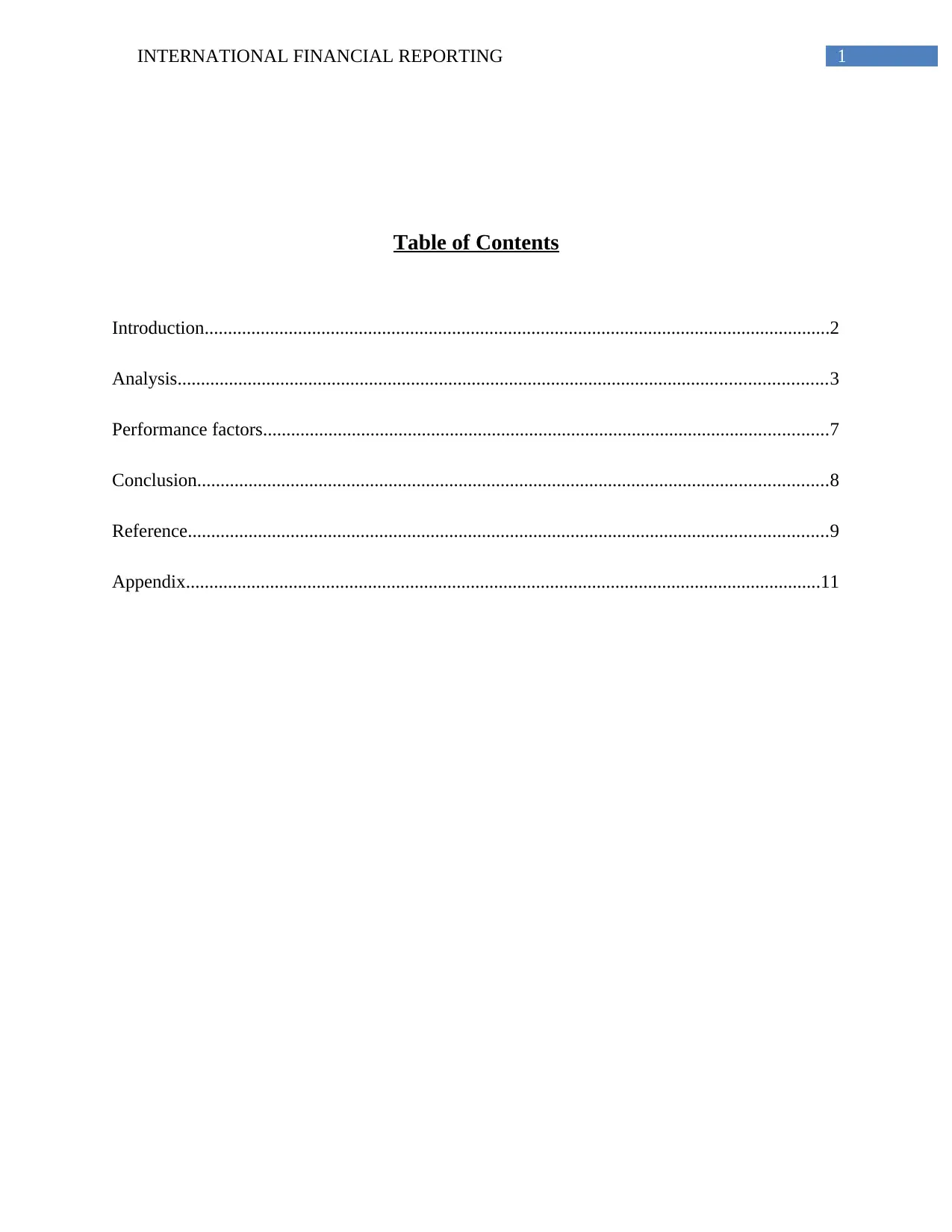
1INTERNATIONAL FINANCIAL REPORTING
Table of Contents
Introduction......................................................................................................................................2
Analysis...........................................................................................................................................3
Performance factors.........................................................................................................................7
Conclusion.......................................................................................................................................8
Reference.........................................................................................................................................9
Appendix........................................................................................................................................11
Table of Contents
Introduction......................................................................................................................................2
Analysis...........................................................................................................................................3
Performance factors.........................................................................................................................7
Conclusion.......................................................................................................................................8
Reference.........................................................................................................................................9
Appendix........................................................................................................................................11
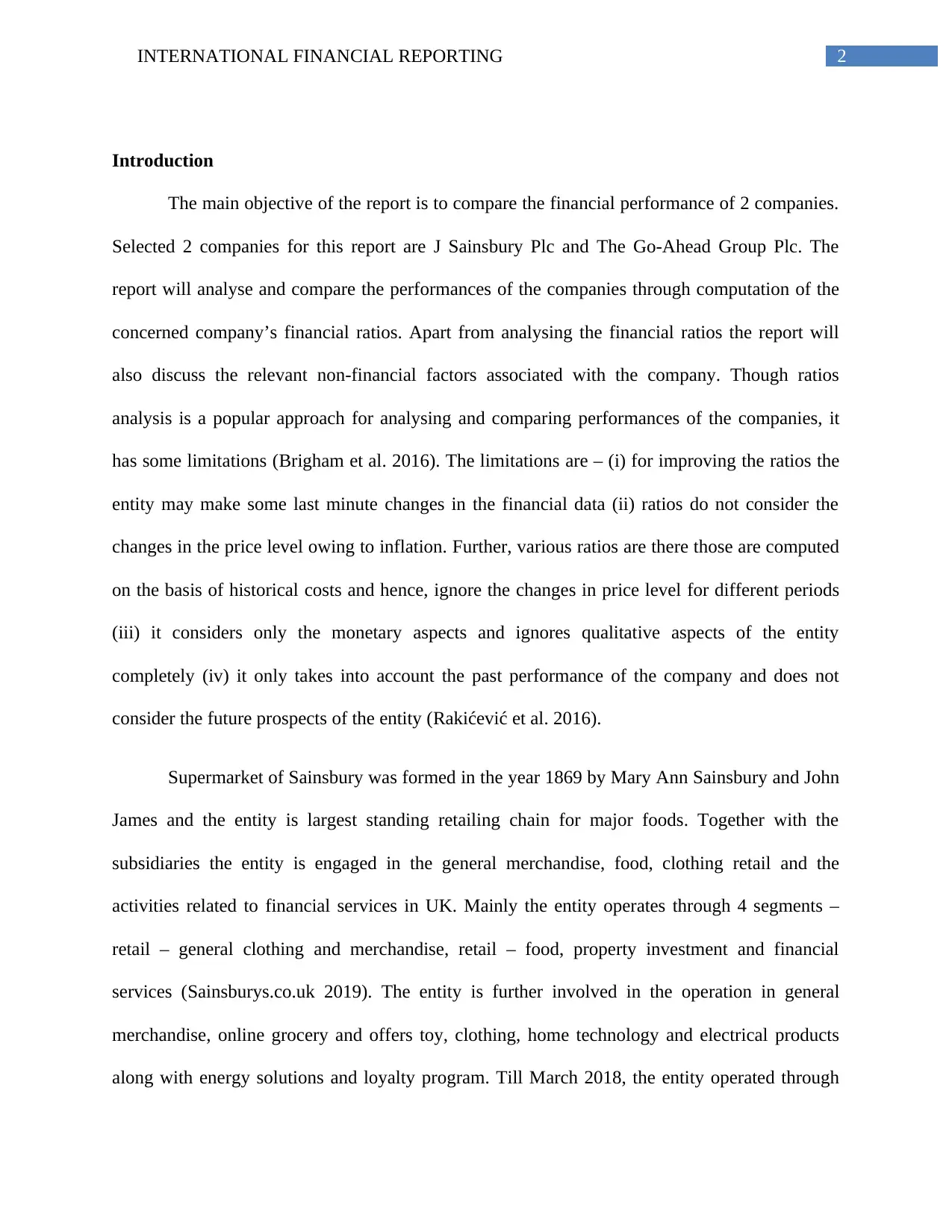
2INTERNATIONAL FINANCIAL REPORTING
Introduction
The main objective of the report is to compare the financial performance of 2 companies.
Selected 2 companies for this report are J Sainsbury Plc and The Go-Ahead Group Plc. The
report will analyse and compare the performances of the companies through computation of the
concerned company’s financial ratios. Apart from analysing the financial ratios the report will
also discuss the relevant non-financial factors associated with the company. Though ratios
analysis is a popular approach for analysing and comparing performances of the companies, it
has some limitations (Brigham et al. 2016). The limitations are – (i) for improving the ratios the
entity may make some last minute changes in the financial data (ii) ratios do not consider the
changes in the price level owing to inflation. Further, various ratios are there those are computed
on the basis of historical costs and hence, ignore the changes in price level for different periods
(iii) it considers only the monetary aspects and ignores qualitative aspects of the entity
completely (iv) it only takes into account the past performance of the company and does not
consider the future prospects of the entity (Rakićević et al. 2016).
Supermarket of Sainsbury was formed in the year 1869 by Mary Ann Sainsbury and John
James and the entity is largest standing retailing chain for major foods. Together with the
subsidiaries the entity is engaged in the general merchandise, food, clothing retail and the
activities related to financial services in UK. Mainly the entity operates through 4 segments –
retail – general clothing and merchandise, retail – food, property investment and financial
services (Sainsburys.co.uk 2019). The entity is further involved in the operation in general
merchandise, online grocery and offers toy, clothing, home technology and electrical products
along with energy solutions and loyalty program. Till March 2018, the entity operated through
Introduction
The main objective of the report is to compare the financial performance of 2 companies.
Selected 2 companies for this report are J Sainsbury Plc and The Go-Ahead Group Plc. The
report will analyse and compare the performances of the companies through computation of the
concerned company’s financial ratios. Apart from analysing the financial ratios the report will
also discuss the relevant non-financial factors associated with the company. Though ratios
analysis is a popular approach for analysing and comparing performances of the companies, it
has some limitations (Brigham et al. 2016). The limitations are – (i) for improving the ratios the
entity may make some last minute changes in the financial data (ii) ratios do not consider the
changes in the price level owing to inflation. Further, various ratios are there those are computed
on the basis of historical costs and hence, ignore the changes in price level for different periods
(iii) it considers only the monetary aspects and ignores qualitative aspects of the entity
completely (iv) it only takes into account the past performance of the company and does not
consider the future prospects of the entity (Rakićević et al. 2016).
Supermarket of Sainsbury was formed in the year 1869 by Mary Ann Sainsbury and John
James and the entity is largest standing retailing chain for major foods. Together with the
subsidiaries the entity is engaged in the general merchandise, food, clothing retail and the
activities related to financial services in UK. Mainly the entity operates through 4 segments –
retail – general clothing and merchandise, retail – food, property investment and financial
services (Sainsburys.co.uk 2019). The entity is further involved in the operation in general
merchandise, online grocery and offers toy, clothing, home technology and electrical products
along with energy solutions and loyalty program. Till March 2018, the entity operated through
⊘ This is a preview!⊘
Do you want full access?
Subscribe today to unlock all pages.

Trusted by 1+ million students worldwide
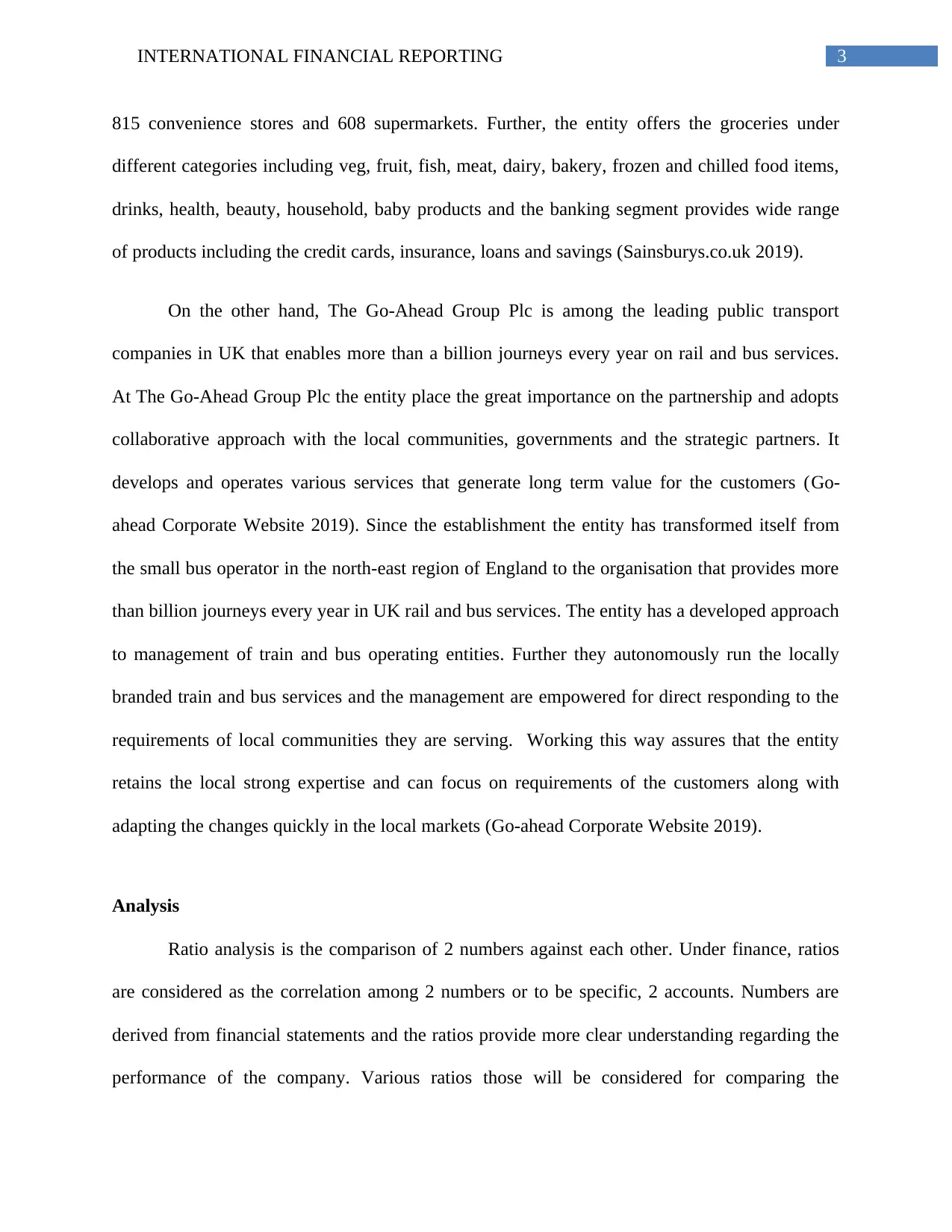
3INTERNATIONAL FINANCIAL REPORTING
815 convenience stores and 608 supermarkets. Further, the entity offers the groceries under
different categories including veg, fruit, fish, meat, dairy, bakery, frozen and chilled food items,
drinks, health, beauty, household, baby products and the banking segment provides wide range
of products including the credit cards, insurance, loans and savings (Sainsburys.co.uk 2019).
On the other hand, The Go-Ahead Group Plc is among the leading public transport
companies in UK that enables more than a billion journeys every year on rail and bus services.
At The Go-Ahead Group Plc the entity place the great importance on the partnership and adopts
collaborative approach with the local communities, governments and the strategic partners. It
develops and operates various services that generate long term value for the customers (Go-
ahead Corporate Website 2019). Since the establishment the entity has transformed itself from
the small bus operator in the north-east region of England to the organisation that provides more
than billion journeys every year in UK rail and bus services. The entity has a developed approach
to management of train and bus operating entities. Further they autonomously run the locally
branded train and bus services and the management are empowered for direct responding to the
requirements of local communities they are serving. Working this way assures that the entity
retains the local strong expertise and can focus on requirements of the customers along with
adapting the changes quickly in the local markets (Go-ahead Corporate Website 2019).
Analysis
Ratio analysis is the comparison of 2 numbers against each other. Under finance, ratios
are considered as the correlation among 2 numbers or to be specific, 2 accounts. Numbers are
derived from financial statements and the ratios provide more clear understanding regarding the
performance of the company. Various ratios those will be considered for comparing the
815 convenience stores and 608 supermarkets. Further, the entity offers the groceries under
different categories including veg, fruit, fish, meat, dairy, bakery, frozen and chilled food items,
drinks, health, beauty, household, baby products and the banking segment provides wide range
of products including the credit cards, insurance, loans and savings (Sainsburys.co.uk 2019).
On the other hand, The Go-Ahead Group Plc is among the leading public transport
companies in UK that enables more than a billion journeys every year on rail and bus services.
At The Go-Ahead Group Plc the entity place the great importance on the partnership and adopts
collaborative approach with the local communities, governments and the strategic partners. It
develops and operates various services that generate long term value for the customers (Go-
ahead Corporate Website 2019). Since the establishment the entity has transformed itself from
the small bus operator in the north-east region of England to the organisation that provides more
than billion journeys every year in UK rail and bus services. The entity has a developed approach
to management of train and bus operating entities. Further they autonomously run the locally
branded train and bus services and the management are empowered for direct responding to the
requirements of local communities they are serving. Working this way assures that the entity
retains the local strong expertise and can focus on requirements of the customers along with
adapting the changes quickly in the local markets (Go-ahead Corporate Website 2019).
Analysis
Ratio analysis is the comparison of 2 numbers against each other. Under finance, ratios
are considered as the correlation among 2 numbers or to be specific, 2 accounts. Numbers are
derived from financial statements and the ratios provide more clear understanding regarding the
performance of the company. Various ratios those will be considered for comparing the
Paraphrase This Document
Need a fresh take? Get an instant paraphrase of this document with our AI Paraphraser
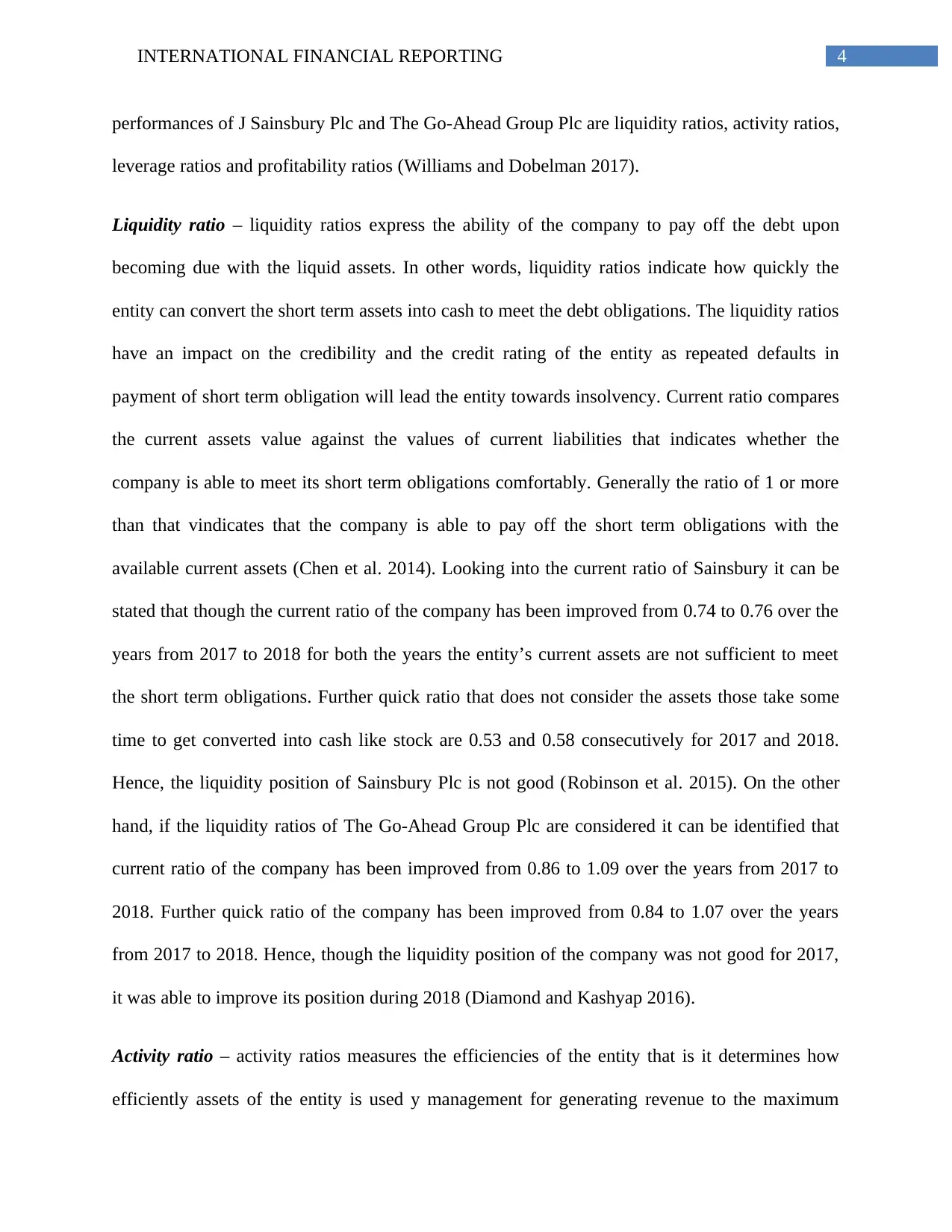
4INTERNATIONAL FINANCIAL REPORTING
performances of J Sainsbury Plc and The Go-Ahead Group Plc are liquidity ratios, activity ratios,
leverage ratios and profitability ratios (Williams and Dobelman 2017).
Liquidity ratio – liquidity ratios express the ability of the company to pay off the debt upon
becoming due with the liquid assets. In other words, liquidity ratios indicate how quickly the
entity can convert the short term assets into cash to meet the debt obligations. The liquidity ratios
have an impact on the credibility and the credit rating of the entity as repeated defaults in
payment of short term obligation will lead the entity towards insolvency. Current ratio compares
the current assets value against the values of current liabilities that indicates whether the
company is able to meet its short term obligations comfortably. Generally the ratio of 1 or more
than that vindicates that the company is able to pay off the short term obligations with the
available current assets (Chen et al. 2014). Looking into the current ratio of Sainsbury it can be
stated that though the current ratio of the company has been improved from 0.74 to 0.76 over the
years from 2017 to 2018 for both the years the entity’s current assets are not sufficient to meet
the short term obligations. Further quick ratio that does not consider the assets those take some
time to get converted into cash like stock are 0.53 and 0.58 consecutively for 2017 and 2018.
Hence, the liquidity position of Sainsbury Plc is not good (Robinson et al. 2015). On the other
hand, if the liquidity ratios of The Go-Ahead Group Plc are considered it can be identified that
current ratio of the company has been improved from 0.86 to 1.09 over the years from 2017 to
2018. Further quick ratio of the company has been improved from 0.84 to 1.07 over the years
from 2017 to 2018. Hence, though the liquidity position of the company was not good for 2017,
it was able to improve its position during 2018 (Diamond and Kashyap 2016).
Activity ratio – activity ratios measures the efficiencies of the entity that is it determines how
efficiently assets of the entity is used y management for generating revenue to the maximum
performances of J Sainsbury Plc and The Go-Ahead Group Plc are liquidity ratios, activity ratios,
leverage ratios and profitability ratios (Williams and Dobelman 2017).
Liquidity ratio – liquidity ratios express the ability of the company to pay off the debt upon
becoming due with the liquid assets. In other words, liquidity ratios indicate how quickly the
entity can convert the short term assets into cash to meet the debt obligations. The liquidity ratios
have an impact on the credibility and the credit rating of the entity as repeated defaults in
payment of short term obligation will lead the entity towards insolvency. Current ratio compares
the current assets value against the values of current liabilities that indicates whether the
company is able to meet its short term obligations comfortably. Generally the ratio of 1 or more
than that vindicates that the company is able to pay off the short term obligations with the
available current assets (Chen et al. 2014). Looking into the current ratio of Sainsbury it can be
stated that though the current ratio of the company has been improved from 0.74 to 0.76 over the
years from 2017 to 2018 for both the years the entity’s current assets are not sufficient to meet
the short term obligations. Further quick ratio that does not consider the assets those take some
time to get converted into cash like stock are 0.53 and 0.58 consecutively for 2017 and 2018.
Hence, the liquidity position of Sainsbury Plc is not good (Robinson et al. 2015). On the other
hand, if the liquidity ratios of The Go-Ahead Group Plc are considered it can be identified that
current ratio of the company has been improved from 0.86 to 1.09 over the years from 2017 to
2018. Further quick ratio of the company has been improved from 0.84 to 1.07 over the years
from 2017 to 2018. Hence, though the liquidity position of the company was not good for 2017,
it was able to improve its position during 2018 (Diamond and Kashyap 2016).
Activity ratio – activity ratios measures the efficiencies of the entity that is it determines how
efficiently assets of the entity is used y management for generating revenue to the maximum
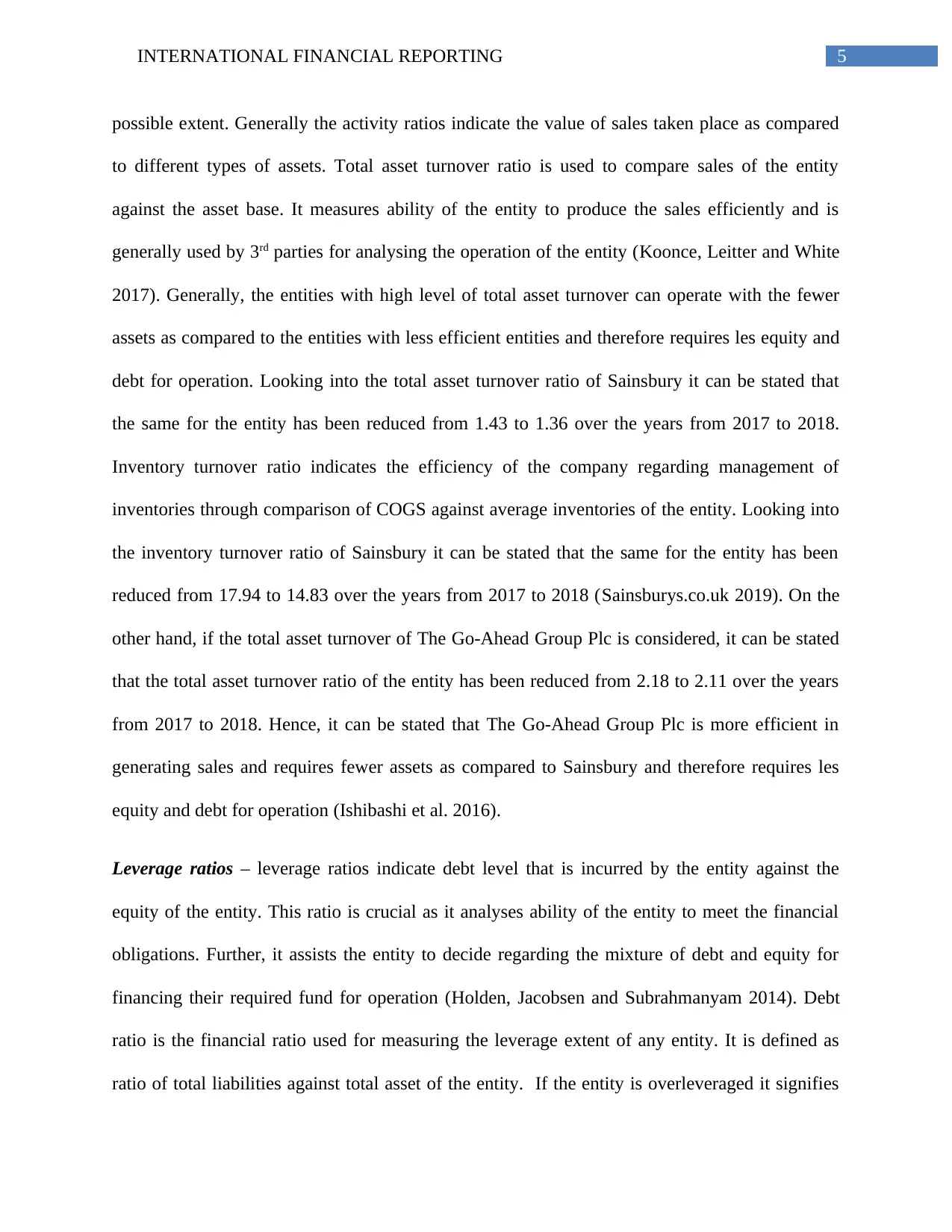
5INTERNATIONAL FINANCIAL REPORTING
possible extent. Generally the activity ratios indicate the value of sales taken place as compared
to different types of assets. Total asset turnover ratio is used to compare sales of the entity
against the asset base. It measures ability of the entity to produce the sales efficiently and is
generally used by 3rd parties for analysing the operation of the entity (Koonce, Leitter and White
2017). Generally, the entities with high level of total asset turnover can operate with the fewer
assets as compared to the entities with less efficient entities and therefore requires les equity and
debt for operation. Looking into the total asset turnover ratio of Sainsbury it can be stated that
the same for the entity has been reduced from 1.43 to 1.36 over the years from 2017 to 2018.
Inventory turnover ratio indicates the efficiency of the company regarding management of
inventories through comparison of COGS against average inventories of the entity. Looking into
the inventory turnover ratio of Sainsbury it can be stated that the same for the entity has been
reduced from 17.94 to 14.83 over the years from 2017 to 2018 (Sainsburys.co.uk 2019). On the
other hand, if the total asset turnover of The Go-Ahead Group Plc is considered, it can be stated
that the total asset turnover ratio of the entity has been reduced from 2.18 to 2.11 over the years
from 2017 to 2018. Hence, it can be stated that The Go-Ahead Group Plc is more efficient in
generating sales and requires fewer assets as compared to Sainsbury and therefore requires les
equity and debt for operation (Ishibashi et al. 2016).
Leverage ratios – leverage ratios indicate debt level that is incurred by the entity against the
equity of the entity. This ratio is crucial as it analyses ability of the entity to meet the financial
obligations. Further, it assists the entity to decide regarding the mixture of debt and equity for
financing their required fund for operation (Holden, Jacobsen and Subrahmanyam 2014). Debt
ratio is the financial ratio used for measuring the leverage extent of any entity. It is defined as
ratio of total liabilities against total asset of the entity. If the entity is overleveraged it signifies
possible extent. Generally the activity ratios indicate the value of sales taken place as compared
to different types of assets. Total asset turnover ratio is used to compare sales of the entity
against the asset base. It measures ability of the entity to produce the sales efficiently and is
generally used by 3rd parties for analysing the operation of the entity (Koonce, Leitter and White
2017). Generally, the entities with high level of total asset turnover can operate with the fewer
assets as compared to the entities with less efficient entities and therefore requires les equity and
debt for operation. Looking into the total asset turnover ratio of Sainsbury it can be stated that
the same for the entity has been reduced from 1.43 to 1.36 over the years from 2017 to 2018.
Inventory turnover ratio indicates the efficiency of the company regarding management of
inventories through comparison of COGS against average inventories of the entity. Looking into
the inventory turnover ratio of Sainsbury it can be stated that the same for the entity has been
reduced from 17.94 to 14.83 over the years from 2017 to 2018 (Sainsburys.co.uk 2019). On the
other hand, if the total asset turnover of The Go-Ahead Group Plc is considered, it can be stated
that the total asset turnover ratio of the entity has been reduced from 2.18 to 2.11 over the years
from 2017 to 2018. Hence, it can be stated that The Go-Ahead Group Plc is more efficient in
generating sales and requires fewer assets as compared to Sainsbury and therefore requires les
equity and debt for operation (Ishibashi et al. 2016).
Leverage ratios – leverage ratios indicate debt level that is incurred by the entity against the
equity of the entity. This ratio is crucial as it analyses ability of the entity to meet the financial
obligations. Further, it assists the entity to decide regarding the mixture of debt and equity for
financing their required fund for operation (Holden, Jacobsen and Subrahmanyam 2014). Debt
ratio is the financial ratio used for measuring the leverage extent of any entity. It is defined as
ratio of total liabilities against total asset of the entity. If the entity is overleveraged it signifies
⊘ This is a preview!⊘
Do you want full access?
Subscribe today to unlock all pages.

Trusted by 1+ million students worldwide
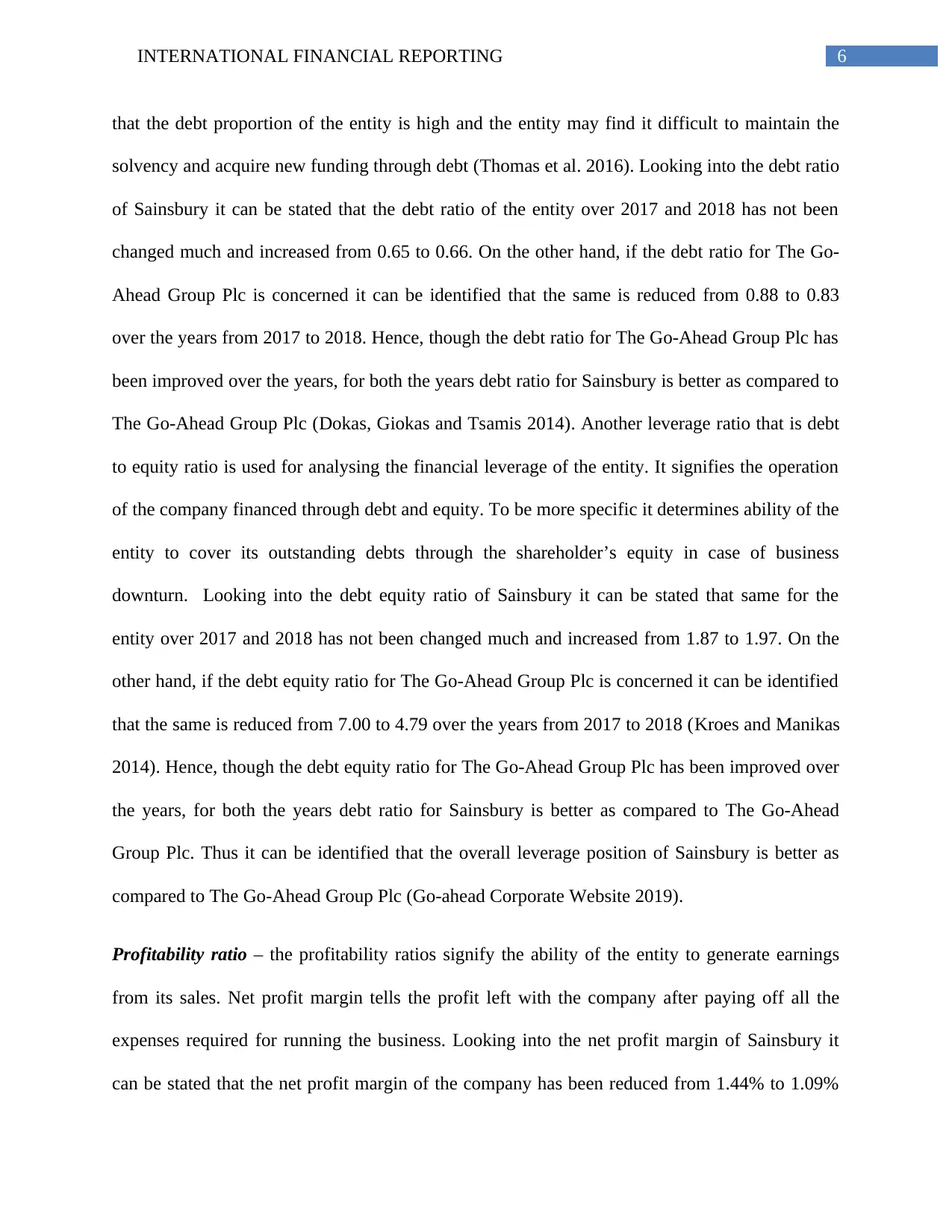
6INTERNATIONAL FINANCIAL REPORTING
that the debt proportion of the entity is high and the entity may find it difficult to maintain the
solvency and acquire new funding through debt (Thomas et al. 2016). Looking into the debt ratio
of Sainsbury it can be stated that the debt ratio of the entity over 2017 and 2018 has not been
changed much and increased from 0.65 to 0.66. On the other hand, if the debt ratio for The Go-
Ahead Group Plc is concerned it can be identified that the same is reduced from 0.88 to 0.83
over the years from 2017 to 2018. Hence, though the debt ratio for The Go-Ahead Group Plc has
been improved over the years, for both the years debt ratio for Sainsbury is better as compared to
The Go-Ahead Group Plc (Dokas, Giokas and Tsamis 2014). Another leverage ratio that is debt
to equity ratio is used for analysing the financial leverage of the entity. It signifies the operation
of the company financed through debt and equity. To be more specific it determines ability of the
entity to cover its outstanding debts through the shareholder’s equity in case of business
downturn. Looking into the debt equity ratio of Sainsbury it can be stated that same for the
entity over 2017 and 2018 has not been changed much and increased from 1.87 to 1.97. On the
other hand, if the debt equity ratio for The Go-Ahead Group Plc is concerned it can be identified
that the same is reduced from 7.00 to 4.79 over the years from 2017 to 2018 (Kroes and Manikas
2014). Hence, though the debt equity ratio for The Go-Ahead Group Plc has been improved over
the years, for both the years debt ratio for Sainsbury is better as compared to The Go-Ahead
Group Plc. Thus it can be identified that the overall leverage position of Sainsbury is better as
compared to The Go-Ahead Group Plc (Go-ahead Corporate Website 2019).
Profitability ratio – the profitability ratios signify the ability of the entity to generate earnings
from its sales. Net profit margin tells the profit left with the company after paying off all the
expenses required for running the business. Looking into the net profit margin of Sainsbury it
can be stated that the net profit margin of the company has been reduced from 1.44% to 1.09%
that the debt proportion of the entity is high and the entity may find it difficult to maintain the
solvency and acquire new funding through debt (Thomas et al. 2016). Looking into the debt ratio
of Sainsbury it can be stated that the debt ratio of the entity over 2017 and 2018 has not been
changed much and increased from 0.65 to 0.66. On the other hand, if the debt ratio for The Go-
Ahead Group Plc is concerned it can be identified that the same is reduced from 0.88 to 0.83
over the years from 2017 to 2018. Hence, though the debt ratio for The Go-Ahead Group Plc has
been improved over the years, for both the years debt ratio for Sainsbury is better as compared to
The Go-Ahead Group Plc (Dokas, Giokas and Tsamis 2014). Another leverage ratio that is debt
to equity ratio is used for analysing the financial leverage of the entity. It signifies the operation
of the company financed through debt and equity. To be more specific it determines ability of the
entity to cover its outstanding debts through the shareholder’s equity in case of business
downturn. Looking into the debt equity ratio of Sainsbury it can be stated that same for the
entity over 2017 and 2018 has not been changed much and increased from 1.87 to 1.97. On the
other hand, if the debt equity ratio for The Go-Ahead Group Plc is concerned it can be identified
that the same is reduced from 7.00 to 4.79 over the years from 2017 to 2018 (Kroes and Manikas
2014). Hence, though the debt equity ratio for The Go-Ahead Group Plc has been improved over
the years, for both the years debt ratio for Sainsbury is better as compared to The Go-Ahead
Group Plc. Thus it can be identified that the overall leverage position of Sainsbury is better as
compared to The Go-Ahead Group Plc (Go-ahead Corporate Website 2019).
Profitability ratio – the profitability ratios signify the ability of the entity to generate earnings
from its sales. Net profit margin tells the profit left with the company after paying off all the
expenses required for running the business. Looking into the net profit margin of Sainsbury it
can be stated that the net profit margin of the company has been reduced from 1.44% to 1.09%
Paraphrase This Document
Need a fresh take? Get an instant paraphrase of this document with our AI Paraphraser
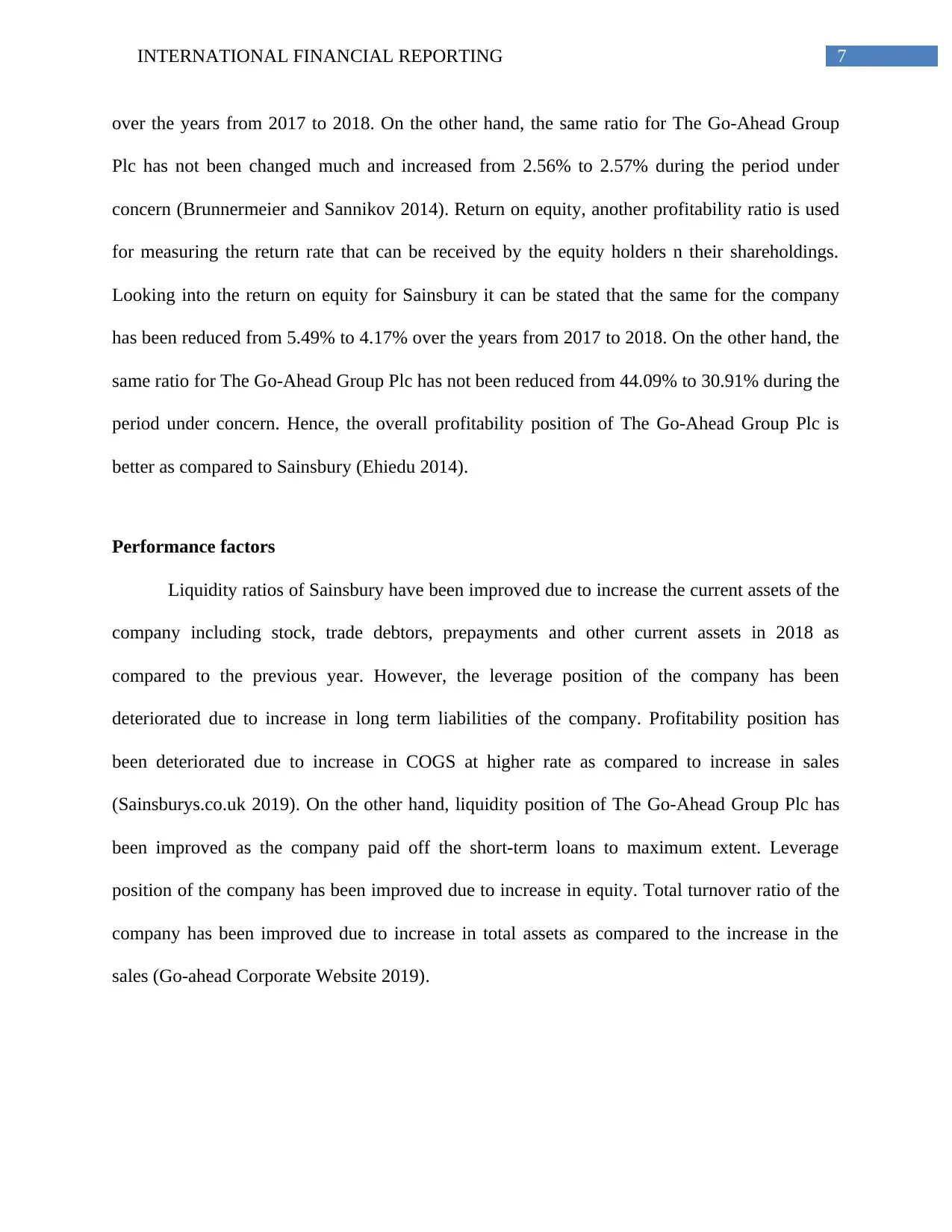
7INTERNATIONAL FINANCIAL REPORTING
over the years from 2017 to 2018. On the other hand, the same ratio for The Go-Ahead Group
Plc has not been changed much and increased from 2.56% to 2.57% during the period under
concern (Brunnermeier and Sannikov 2014). Return on equity, another profitability ratio is used
for measuring the return rate that can be received by the equity holders n their shareholdings.
Looking into the return on equity for Sainsbury it can be stated that the same for the company
has been reduced from 5.49% to 4.17% over the years from 2017 to 2018. On the other hand, the
same ratio for The Go-Ahead Group Plc has not been reduced from 44.09% to 30.91% during the
period under concern. Hence, the overall profitability position of The Go-Ahead Group Plc is
better as compared to Sainsbury (Ehiedu 2014).
Performance factors
Liquidity ratios of Sainsbury have been improved due to increase the current assets of the
company including stock, trade debtors, prepayments and other current assets in 2018 as
compared to the previous year. However, the leverage position of the company has been
deteriorated due to increase in long term liabilities of the company. Profitability position has
been deteriorated due to increase in COGS at higher rate as compared to increase in sales
(Sainsburys.co.uk 2019). On the other hand, liquidity position of The Go-Ahead Group Plc has
been improved as the company paid off the short-term loans to maximum extent. Leverage
position of the company has been improved due to increase in equity. Total turnover ratio of the
company has been improved due to increase in total assets as compared to the increase in the
sales (Go-ahead Corporate Website 2019).
over the years from 2017 to 2018. On the other hand, the same ratio for The Go-Ahead Group
Plc has not been changed much and increased from 2.56% to 2.57% during the period under
concern (Brunnermeier and Sannikov 2014). Return on equity, another profitability ratio is used
for measuring the return rate that can be received by the equity holders n their shareholdings.
Looking into the return on equity for Sainsbury it can be stated that the same for the company
has been reduced from 5.49% to 4.17% over the years from 2017 to 2018. On the other hand, the
same ratio for The Go-Ahead Group Plc has not been reduced from 44.09% to 30.91% during the
period under concern. Hence, the overall profitability position of The Go-Ahead Group Plc is
better as compared to Sainsbury (Ehiedu 2014).
Performance factors
Liquidity ratios of Sainsbury have been improved due to increase the current assets of the
company including stock, trade debtors, prepayments and other current assets in 2018 as
compared to the previous year. However, the leverage position of the company has been
deteriorated due to increase in long term liabilities of the company. Profitability position has
been deteriorated due to increase in COGS at higher rate as compared to increase in sales
(Sainsburys.co.uk 2019). On the other hand, liquidity position of The Go-Ahead Group Plc has
been improved as the company paid off the short-term loans to maximum extent. Leverage
position of the company has been improved due to increase in equity. Total turnover ratio of the
company has been improved due to increase in total assets as compared to the increase in the
sales (Go-ahead Corporate Website 2019).
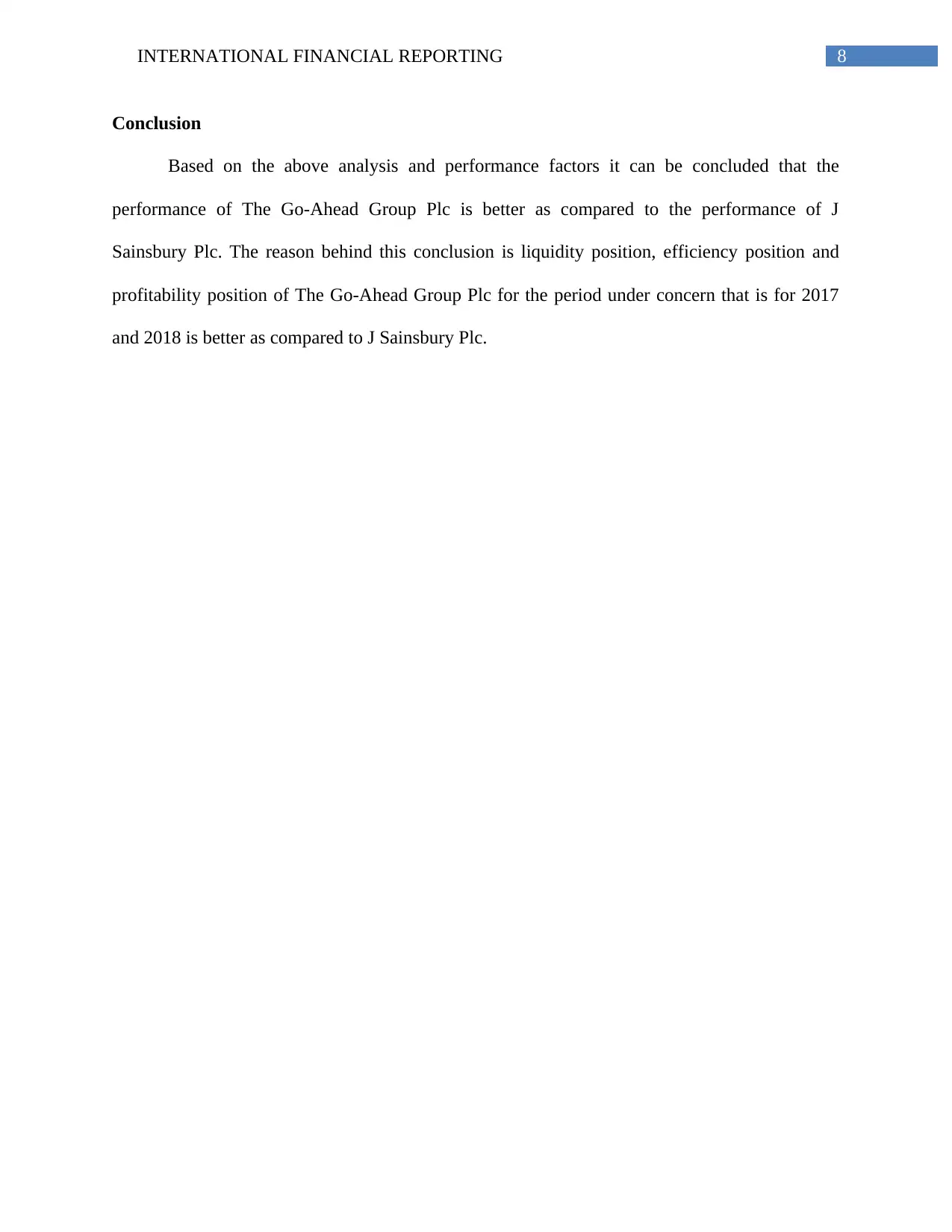
8INTERNATIONAL FINANCIAL REPORTING
Conclusion
Based on the above analysis and performance factors it can be concluded that the
performance of The Go-Ahead Group Plc is better as compared to the performance of J
Sainsbury Plc. The reason behind this conclusion is liquidity position, efficiency position and
profitability position of The Go-Ahead Group Plc for the period under concern that is for 2017
and 2018 is better as compared to J Sainsbury Plc.
Conclusion
Based on the above analysis and performance factors it can be concluded that the
performance of The Go-Ahead Group Plc is better as compared to the performance of J
Sainsbury Plc. The reason behind this conclusion is liquidity position, efficiency position and
profitability position of The Go-Ahead Group Plc for the period under concern that is for 2017
and 2018 is better as compared to J Sainsbury Plc.
⊘ This is a preview!⊘
Do you want full access?
Subscribe today to unlock all pages.

Trusted by 1+ million students worldwide
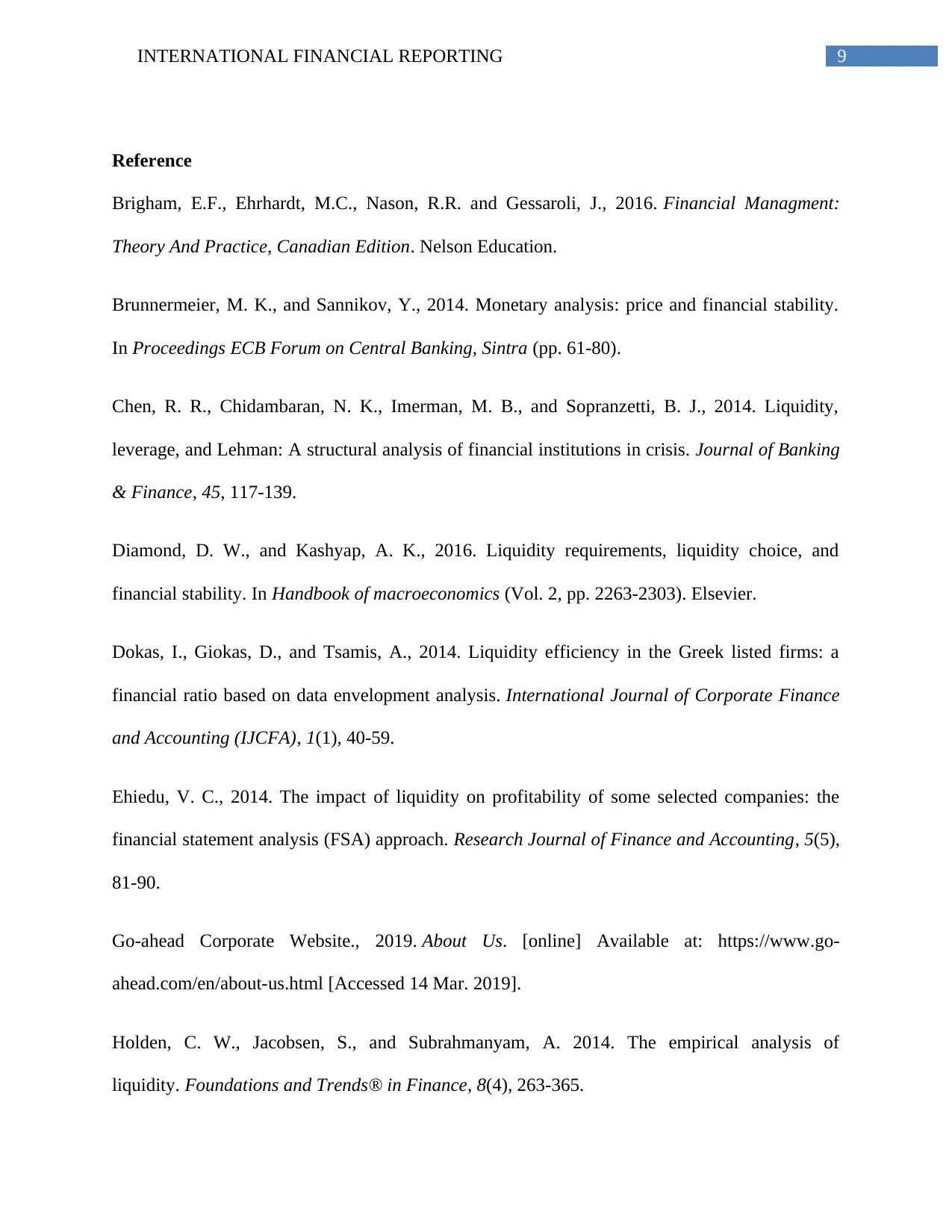
9INTERNATIONAL FINANCIAL REPORTING
Reference
Brigham, E.F., Ehrhardt, M.C., Nason, R.R. and Gessaroli, J., 2016. Financial Managment:
Theory And Practice, Canadian Edition. Nelson Education.
Brunnermeier, M. K., and Sannikov, Y., 2014. Monetary analysis: price and financial stability.
In Proceedings ECB Forum on Central Banking, Sintra (pp. 61-80).
Chen, R. R., Chidambaran, N. K., Imerman, M. B., and Sopranzetti, B. J., 2014. Liquidity,
leverage, and Lehman: A structural analysis of financial institutions in crisis. Journal of Banking
& Finance, 45, 117-139.
Diamond, D. W., and Kashyap, A. K., 2016. Liquidity requirements, liquidity choice, and
financial stability. In Handbook of macroeconomics (Vol. 2, pp. 2263-2303). Elsevier.
Dokas, I., Giokas, D., and Tsamis, A., 2014. Liquidity efficiency in the Greek listed firms: a
financial ratio based on data envelopment analysis. International Journal of Corporate Finance
and Accounting (IJCFA), 1(1), 40-59.
Ehiedu, V. C., 2014. The impact of liquidity on profitability of some selected companies: the
financial statement analysis (FSA) approach. Research Journal of Finance and Accounting, 5(5),
81-90.
Go-ahead Corporate Website., 2019. About Us. [online] Available at: https://www.go-
ahead.com/en/about-us.html [Accessed 14 Mar. 2019].
Holden, C. W., Jacobsen, S., and Subrahmanyam, A. 2014. The empirical analysis of
liquidity. Foundations and Trends® in Finance, 8(4), 263-365.
Reference
Brigham, E.F., Ehrhardt, M.C., Nason, R.R. and Gessaroli, J., 2016. Financial Managment:
Theory And Practice, Canadian Edition. Nelson Education.
Brunnermeier, M. K., and Sannikov, Y., 2014. Monetary analysis: price and financial stability.
In Proceedings ECB Forum on Central Banking, Sintra (pp. 61-80).
Chen, R. R., Chidambaran, N. K., Imerman, M. B., and Sopranzetti, B. J., 2014. Liquidity,
leverage, and Lehman: A structural analysis of financial institutions in crisis. Journal of Banking
& Finance, 45, 117-139.
Diamond, D. W., and Kashyap, A. K., 2016. Liquidity requirements, liquidity choice, and
financial stability. In Handbook of macroeconomics (Vol. 2, pp. 2263-2303). Elsevier.
Dokas, I., Giokas, D., and Tsamis, A., 2014. Liquidity efficiency in the Greek listed firms: a
financial ratio based on data envelopment analysis. International Journal of Corporate Finance
and Accounting (IJCFA), 1(1), 40-59.
Ehiedu, V. C., 2014. The impact of liquidity on profitability of some selected companies: the
financial statement analysis (FSA) approach. Research Journal of Finance and Accounting, 5(5),
81-90.
Go-ahead Corporate Website., 2019. About Us. [online] Available at: https://www.go-
ahead.com/en/about-us.html [Accessed 14 Mar. 2019].
Holden, C. W., Jacobsen, S., and Subrahmanyam, A. 2014. The empirical analysis of
liquidity. Foundations and Trends® in Finance, 8(4), 263-365.
Paraphrase This Document
Need a fresh take? Get an instant paraphrase of this document with our AI Paraphraser
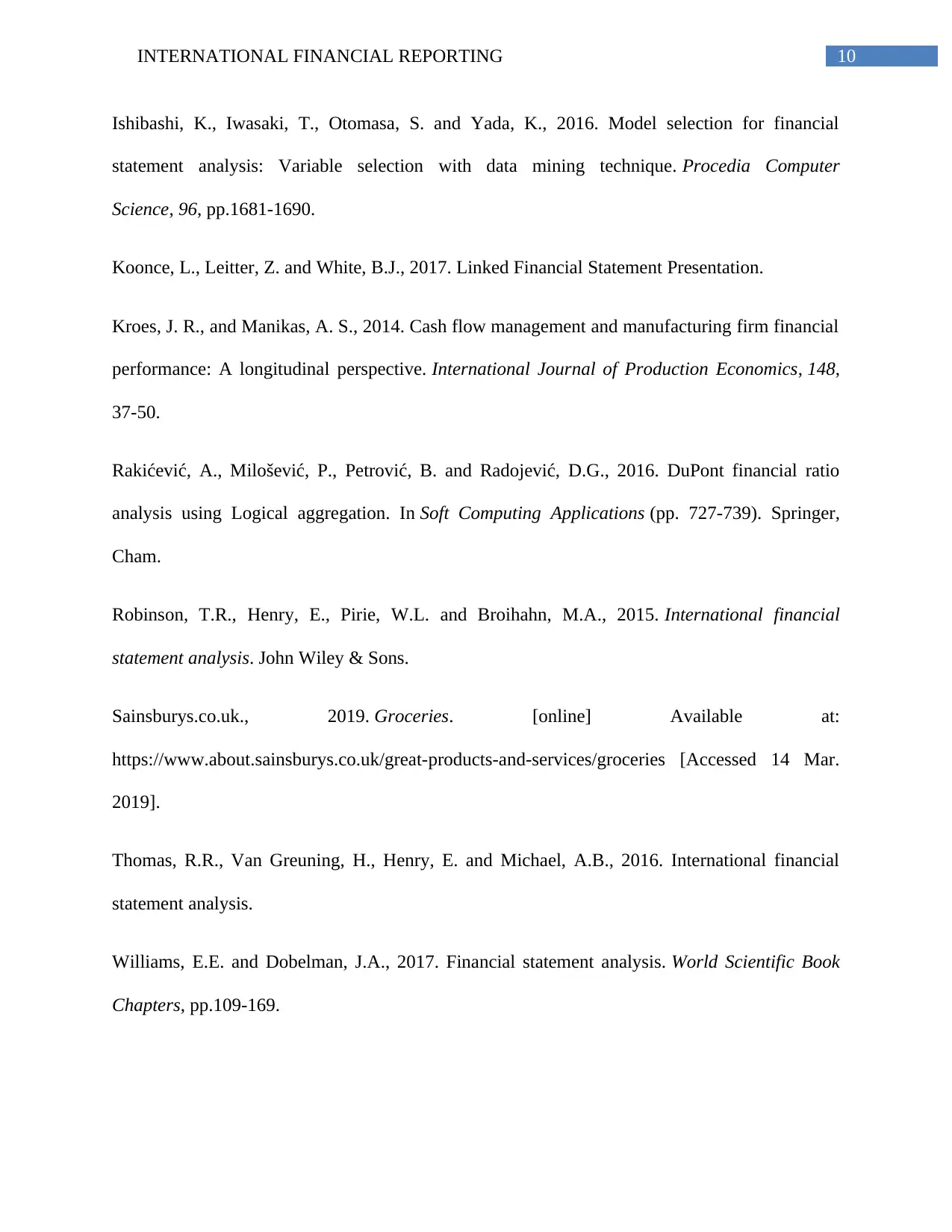
10INTERNATIONAL FINANCIAL REPORTING
Ishibashi, K., Iwasaki, T., Otomasa, S. and Yada, K., 2016. Model selection for financial
statement analysis: Variable selection with data mining technique. Procedia Computer
Science, 96, pp.1681-1690.
Koonce, L., Leitter, Z. and White, B.J., 2017. Linked Financial Statement Presentation.
Kroes, J. R., and Manikas, A. S., 2014. Cash flow management and manufacturing firm financial
performance: A longitudinal perspective. International Journal of Production Economics, 148,
37-50.
Rakićević, A., Milošević, P., Petrović, B. and Radojević, D.G., 2016. DuPont financial ratio
analysis using Logical aggregation. In Soft Computing Applications (pp. 727-739). Springer,
Cham.
Robinson, T.R., Henry, E., Pirie, W.L. and Broihahn, M.A., 2015. International financial
statement analysis. John Wiley & Sons.
Sainsburys.co.uk., 2019. Groceries. [online] Available at:
https://www.about.sainsburys.co.uk/great-products-and-services/groceries [Accessed 14 Mar.
2019].
Thomas, R.R., Van Greuning, H., Henry, E. and Michael, A.B., 2016. International financial
statement analysis.
Williams, E.E. and Dobelman, J.A., 2017. Financial statement analysis. World Scientific Book
Chapters, pp.109-169.
Ishibashi, K., Iwasaki, T., Otomasa, S. and Yada, K., 2016. Model selection for financial
statement analysis: Variable selection with data mining technique. Procedia Computer
Science, 96, pp.1681-1690.
Koonce, L., Leitter, Z. and White, B.J., 2017. Linked Financial Statement Presentation.
Kroes, J. R., and Manikas, A. S., 2014. Cash flow management and manufacturing firm financial
performance: A longitudinal perspective. International Journal of Production Economics, 148,
37-50.
Rakićević, A., Milošević, P., Petrović, B. and Radojević, D.G., 2016. DuPont financial ratio
analysis using Logical aggregation. In Soft Computing Applications (pp. 727-739). Springer,
Cham.
Robinson, T.R., Henry, E., Pirie, W.L. and Broihahn, M.A., 2015. International financial
statement analysis. John Wiley & Sons.
Sainsburys.co.uk., 2019. Groceries. [online] Available at:
https://www.about.sainsburys.co.uk/great-products-and-services/groceries [Accessed 14 Mar.
2019].
Thomas, R.R., Van Greuning, H., Henry, E. and Michael, A.B., 2016. International financial
statement analysis.
Williams, E.E. and Dobelman, J.A., 2017. Financial statement analysis. World Scientific Book
Chapters, pp.109-169.
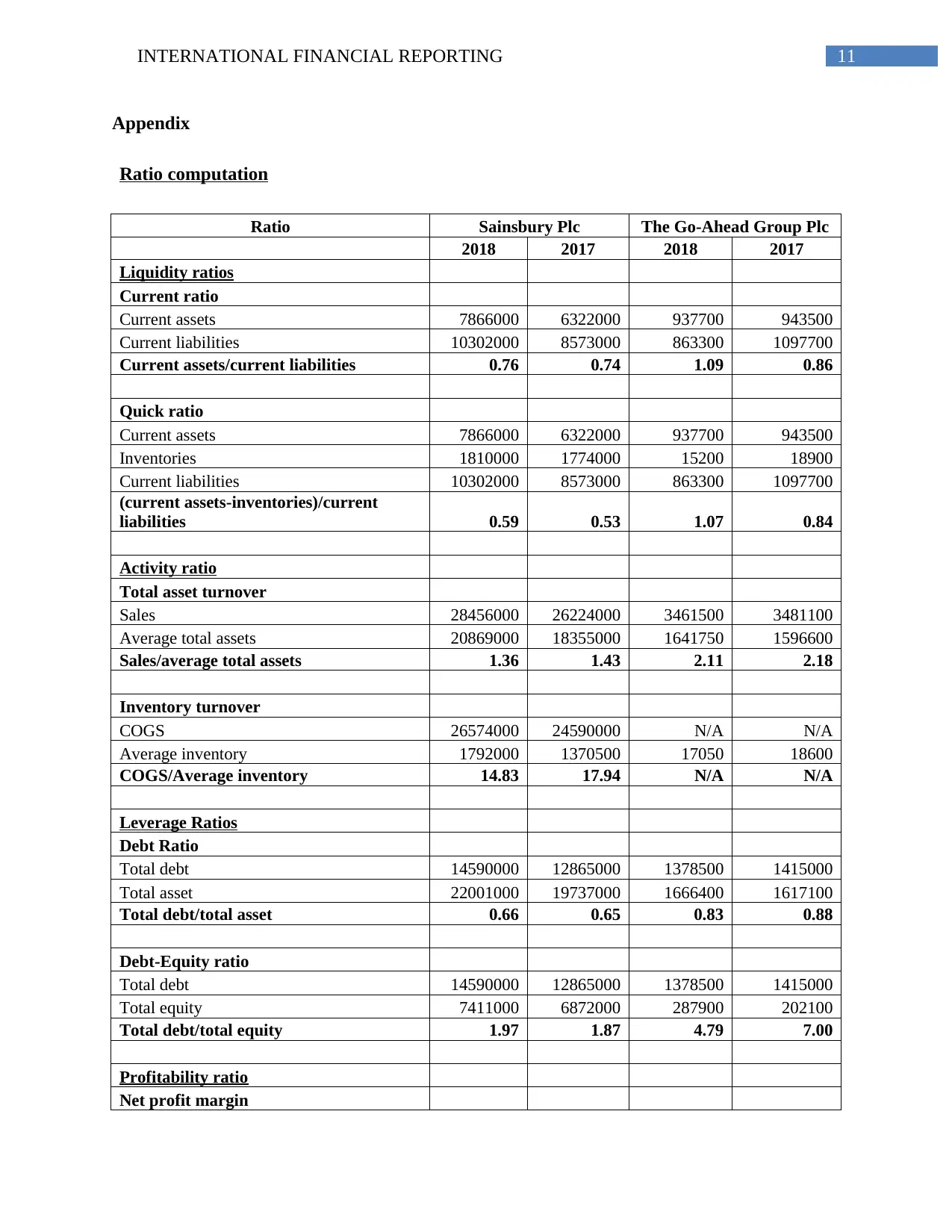
11INTERNATIONAL FINANCIAL REPORTING
Appendix
Ratio computation
Ratio Sainsbury Plc The Go-Ahead Group Plc
2018 2017 2018 2017
Liquidity ratios
Current ratio
Current assets 7866000 6322000 937700 943500
Current liabilities 10302000 8573000 863300 1097700
Current assets/current liabilities 0.76 0.74 1.09 0.86
Quick ratio
Current assets 7866000 6322000 937700 943500
Inventories 1810000 1774000 15200 18900
Current liabilities 10302000 8573000 863300 1097700
(current assets-inventories)/current
liabilities 0.59 0.53 1.07 0.84
Activity ratio
Total asset turnover
Sales 28456000 26224000 3461500 3481100
Average total assets 20869000 18355000 1641750 1596600
Sales/average total assets 1.36 1.43 2.11 2.18
Inventory turnover
COGS 26574000 24590000 N/A N/A
Average inventory 1792000 1370500 17050 18600
COGS/Average inventory 14.83 17.94 N/A N/A
Leverage Ratios
Debt Ratio
Total debt 14590000 12865000 1378500 1415000
Total asset 22001000 19737000 1666400 1617100
Total debt/total asset 0.66 0.65 0.83 0.88
Debt-Equity ratio
Total debt 14590000 12865000 1378500 1415000
Total equity 7411000 6872000 287900 202100
Total debt/total equity 1.97 1.87 4.79 7.00
Profitability ratio
Net profit margin
Appendix
Ratio computation
Ratio Sainsbury Plc The Go-Ahead Group Plc
2018 2017 2018 2017
Liquidity ratios
Current ratio
Current assets 7866000 6322000 937700 943500
Current liabilities 10302000 8573000 863300 1097700
Current assets/current liabilities 0.76 0.74 1.09 0.86
Quick ratio
Current assets 7866000 6322000 937700 943500
Inventories 1810000 1774000 15200 18900
Current liabilities 10302000 8573000 863300 1097700
(current assets-inventories)/current
liabilities 0.59 0.53 1.07 0.84
Activity ratio
Total asset turnover
Sales 28456000 26224000 3461500 3481100
Average total assets 20869000 18355000 1641750 1596600
Sales/average total assets 1.36 1.43 2.11 2.18
Inventory turnover
COGS 26574000 24590000 N/A N/A
Average inventory 1792000 1370500 17050 18600
COGS/Average inventory 14.83 17.94 N/A N/A
Leverage Ratios
Debt Ratio
Total debt 14590000 12865000 1378500 1415000
Total asset 22001000 19737000 1666400 1617100
Total debt/total asset 0.66 0.65 0.83 0.88
Debt-Equity ratio
Total debt 14590000 12865000 1378500 1415000
Total equity 7411000 6872000 287900 202100
Total debt/total equity 1.97 1.87 4.79 7.00
Profitability ratio
Net profit margin
⊘ This is a preview!⊘
Do you want full access?
Subscribe today to unlock all pages.

Trusted by 1+ million students worldwide
1 out of 13
Related Documents
Your All-in-One AI-Powered Toolkit for Academic Success.
+13062052269
info@desklib.com
Available 24*7 on WhatsApp / Email
![[object Object]](/_next/static/media/star-bottom.7253800d.svg)
Unlock your academic potential
Copyright © 2020–2025 A2Z Services. All Rights Reserved. Developed and managed by ZUCOL.





